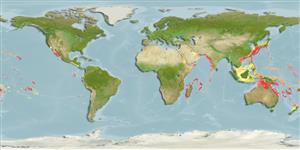>
Aulopiformes (Grinners) >
Synodontidae (Lizardfishes) > Synodontinae
Etymology: Synodus: Greek, syn, symphysis = grown together + Greek, odous = teeth (Ref. 45335); doaki: Named after Wade Doak, pioneer New Zealand diver and underwater naturalist who first discovered this fish at the Poor Knights Islands.
Eponymy: Wade Thomas Doak (1940–2019) was a pioneering New Zealand diver and underwater naturalist, who discovered this species at Poor Knights Islands, off eastern Northland, New Zealand. He wrote: Sharks and Other Ancestors (1976). (Ref. 128868), visit book page.
Environment: milieu / climate zone / Tiefenbereich / distribution range
Ökologie
seewasser riff-verbunden; tiefenbereich 9 - 260 m (Ref. 58302). Temperate
Indo-Pacific: East Africa, Japan, Chesterfield Islands (Ref. 11897), eastern Australia, northern New Zealand (Ref. 9818) and Hawaiian Islands (Ref. 58302). Southeast Pacific: Nazca and Sala-y-Gomez (Ref. 50546).
Size / Gewicht / Alter
Geschlechtsreife: Lm ? range ? - ? cm
Max length : 28.0 cm TL Männchen/unbestimmt; (Ref. 2334)
Rückenflossenstacheln (insgesamt) : 0; Rückenflossenweichstrahlen (insgesamt) : 13 - 15; Afterflossenstacheln: 0; Afterflossenweichstrahlen: 8 - 9. Cheek scaled to margin of preopercle; flap on anterior nostrils very long and rounded; pectoral fins reaching a line connecting origins of dorsal and pelvic fins. The irregular bars and spots on the body red, the centers of larger markings sometimes yellow. All fins with transverse red bands.
Body shape (shape guide): elongated; Cross section: circular.
Benthic (Ref. 58302). Inhabits sandy bottoms close to rock or coral outcrops. In New Zealand, frequently seen in pairs (Ref. 9818).
Life cycle and mating behavior
Geschlechtsreife | Fortpflanzung | Ablaichen | Eier | Fecundity | Larven
Randall, J.E., G.R. Allen and R.C. Steene, 1990. Fishes of the Great Barrier Reef and Coral Sea. University of Hawaii Press, Honolulu, Hawaii. 506 p. (Ref. 2334)
IUCN Rote Liste Status (Ref. 130435: Version 2025-1)
Bedrohung für Menschen
Harmless
Nutzung durch Menschen
Tools
Zusatzinformationen
Download XML
Internet Quellen
Estimates based on models
Preferred temperature (Ref.
123201): 17.1 - 27.3, mean 23.7 °C (based on 161 cells).
Phylogenetic diversity index (Ref.
82804): PD
50 = 0.5000 [Uniqueness, from 0.5 = low to 2.0 = high].
Bayesian length-weight: a=0.00457 (0.00221 - 0.00945), b=3.16 (2.99 - 3.33), in cm total length, based on LWR estimates for this Genus-body shape (Ref.
93245).
Trophic level (Ref.
69278): 4.1 ±0.7 se; based on size and trophs of closest relatives
Widerstandsfähigkeit (Ref.
120179): hoch, Verdopplung der Population dauert weniger als 15 Monate. (Preliminary K or Fecundity.).
Fishing Vulnerability (Ref.
59153): Low vulnerability (18 of 100).
🛈
Nutrients (Ref.
124155): Calcium = 17.3 [5.3, 41.1] mg/100g; Iron = 0.189 [0.062, 0.429] mg/100g; Protein = 16.1 [13.2, 18.5] %; Omega3 = 0.195 [0.063, 0.531] g/100g; Selenium = 9.58 [3.21, 24.42] μg/100g; VitaminA = 69 [15, 308] μg/100g; Zinc = 0.439 [0.246, 0.723] mg/100g (wet weight);
